Marine Corps Harrier shoots down seven UAVs
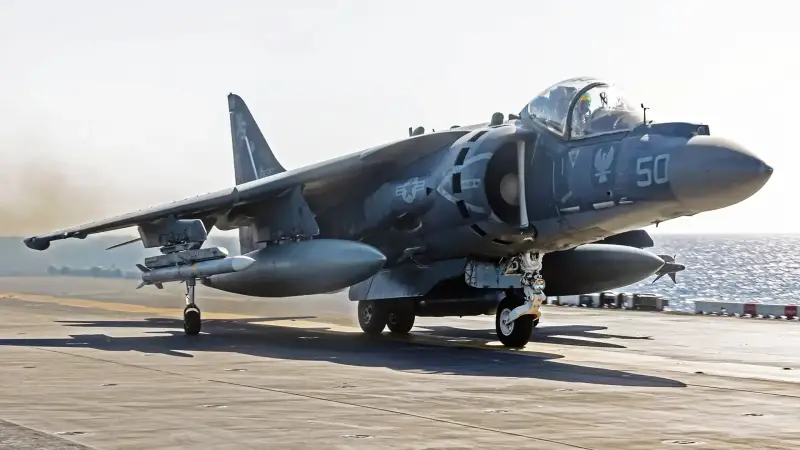
Based on an article in The WarZone magazine signed Thomas newdick. Almost literal translation.
Why I was interested in this is probably because the Harrier is still not a fighter, although in the Falklands it had to act in this capacity. And the most interesting thing is at the very end, as expected.
Exactly how many drones were shot down by Harriers?
Marine Corps AV-8B Harrier II (subsonic vertical take-off attack aircraft) have reportedly intercepted numerous droneslaunched by the Houthis in the Red Sea, as well as aimed at striking Israel. It is unclear exactly how many drones were shot down by the Harriers. So far, we have heard and continue to read reports of US and allied ships shooting down Houthi UAVs and missiles.
It also talks about UAVs destroyed in the air by US Navy F/A-18 Super Hornets and unnamed ground-based C-fighters. Recent reports shed light on the AV-8B's airborne attack capabilities.
Note. Just in case, I’ll explain why in the article about aviation the Air Force, the Navy, and even the Marine Corps are mentioned - because our neighbors across the ocean have an Air Force like view armed forces, and aviation of the Navy, Marine Corps and even the National Guard is race troops included in the above type of armed forces.
In an interview with the BBC on February 10, 2024, Harrier pilot Capt. Earl Ehrhart said that he personally intercepted seven drones. The WarZone is trying to figure out if there was any of these drones shot down by Captain Earhart, and what capabilities does the attack aircraft have for this.
Earhart serves with Attack Squadron 231 (VMA-231), which is stationed aboard the amphibious assault ship USS Bataan. Since the end of December, the ship operated in the Mediterranean Sea, but in October, when the Houthi campaign and military operations in Gaza began, the ship was in the Red Sea and the Persian Gulf. It is not entirely clear in which areas Earhart carried out the tasks in question.
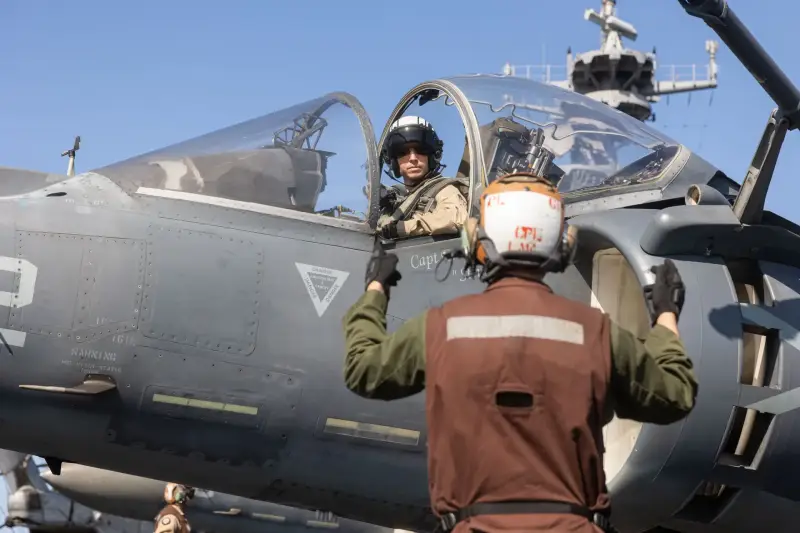
Captain Earhart, December 26, 2023, USS Bataan
Earhart believes the squadron never expected to engage in dogfights with any enemy. To operate for air defense purposes, the Harriers had to be modified and armed with missiles. It is not specified which missiles are used.
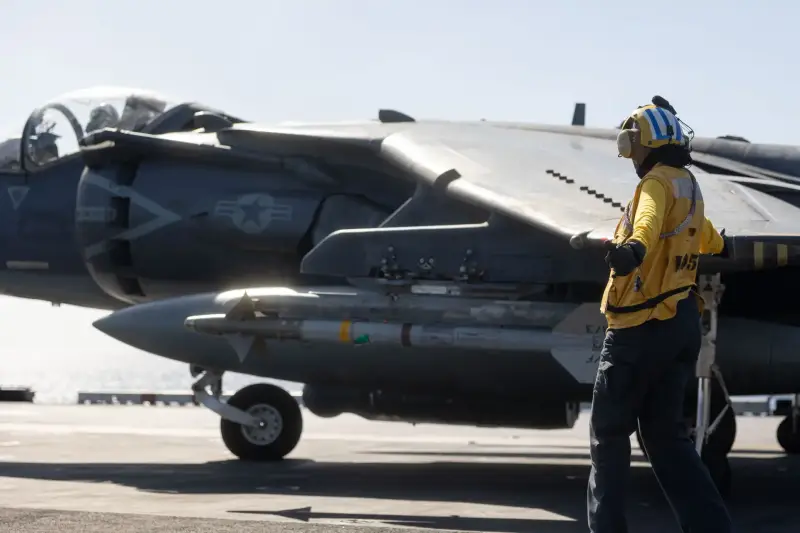
An AV-8B armed with a live AIM-9L/M Sidewinder missile aboard the amphibious assault ship USS Bataan on December 26, 2023
However, the Marine Corps' Harriers can be armed with both AIM-120 active radar seeker missiles and AIM-9L/M infrared seeker missiles. The aircraft can also be equipped with a suspended container with a GAU-12 cannon of 25 mm caliber, with 250 rounds of ammunition.
Photos of attack aircraft aboard the USS Bataan released by the US Department of Defense show that the aircraft also have so-called Litening targeting pods.
Litening targeting pod – a hanging container for illuminating a target day and night, in difficult weather conditions. It significantly increases the ability to identify a target and get where you need to go.
Lightening pod helps visually identify a target at very long distances and can exchange information with radar.
However, the same article on the BBC website states that some drones were intercepted at such a distance that the explosion of their ammunition could seriously damage the interceptor itself. Aircraft searching for and attacking low-speed, low-flying targets expose themselves to considerable risk.
According to Earhart's interview, USS Bataan always had more than one AV-8B attack aircraft on standby in case of drone attacks. The targeting apparently came from one of the guided missile destroyers nearby, which was using its Aegis system. Earhart:
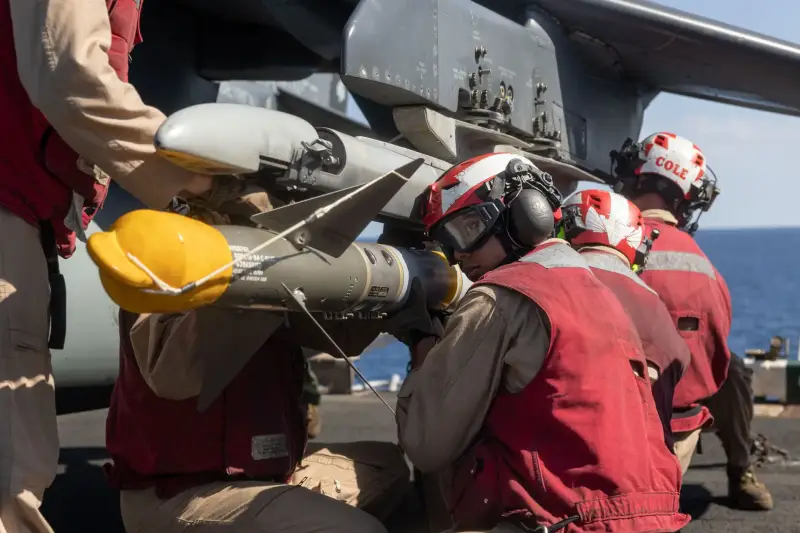
An AIM-9M Sidewinder is loaded onto AV-8B aboard USS Bataan, December 26, 2023
Obviously, the use of Harrier attack aircraft to combat UAVs was primarily due to their availability in the region. It is worth noting that the AV-8B has very significant, although often overlooked, capabilities for combating air targets.
The AV-8B+ variant is equipped with the AN/APG-65 radar, which was once carried by the F/A-18A/B Hornet and then transferred to the Harriers. Since then, it (the Harrier) has undergone several upgrades and now, in combination with AMRAAM missiles, also has serious air-to-air capabilities among its wide range of applications. From the experience of the Royal Saudi Air Force, it is known that AMRAAM missiles are excellent weapon against drones launched by the Houthis.
Saudi F-15 shoots down Iranian UAV
Sidewinder missiles are not very good against UAVs, which have very limited thermal signature. The former F-15 pilot recalls that while AMRAAM is not the only option in this type of combat, “it may be the best, depending on the size of the target and the type of engine.
Due to an insufficient heat signature, you may not receive a signal (audio) until you enter the minimum range - at the same time, this will render the Sidwinder missile useless. As for the radar signature, the UAV has enough of it.”
On the other hand, when flying over the sea, the Sidewinder missile may have more opportunities to “catch” the UAV’s heat signature.
As for firing a cannon at a small target, this is considered quite difficult for a pilot who has not received special training, and it is completely unclear whether Harrier pilots were trained in such methods.
Additionally, it can be dangerous due to the threat of collision with such a small target. The same former pilot describes it this way: “a gun is possible, although very difficult. But it’s also a lot of fun.”
It's worth remembering that the AV-8 has some unique capabilities that make it a very useful platform for engaging slow-moving targets: its four thrust-vectoring nozzles combined with... (sorry, this is where it became unclear to me - what reaction control vanes are... some kind of rotary vanes... it’s only clear that this concerns the propulsion system)... In general, this property provides the aircraft with excellent low-speed flight qualities, which can be useful in battles with slow-moving drones.
While we don't know what types of drones were intercepted, the Iranian-made Shahed-136 UAV used by the Houthis and Russia has a top speed of only about 115 mph.
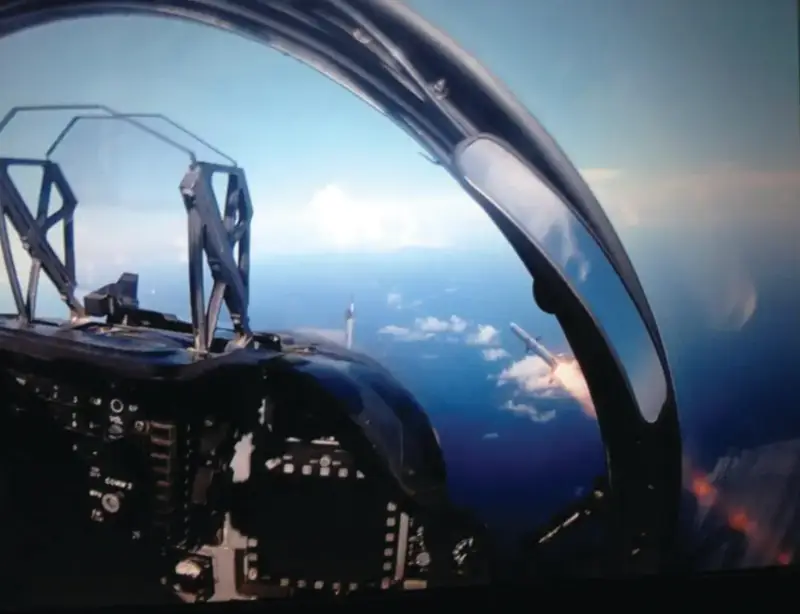
AV-8B launched an AIM-120 AMRAAM missile over Florida for the first time operationally, August 2012
While the Harrier doesn't have the capabilities of, say, a Super Hornet, it does provide an extra layer of protection to its mothership. In addition, the pilot can visually identify a potential threat, and this also creates an advantage over “inanimate” missiles. This flexibility is very useful in such a complex area, which is now the Red Sea.
It is also reported that aircraft from the USS Bataan participated in air strikes not only against Houthi-occupied territory in Yemen, but also against targets in Iraq and Syria. This suggests that the planes took off from the ship while it was in the Mediterranean Sea.
As for downed drones, since October 7, victories have been won by the US Navy, the Israeli Air Force and, apparently, the US Air Force. It is very possible that the Saudi Arabian Air Force also participated in repelling the attacks. Since the Houthis don't seem to be stopping, the Marine Corps can be added to the list.
This is where the article ends. You can also look at the author of the interview.

What can I say?
Racing an attack aircraft, much less a fighter, for a UAV worth 5 thousand dollars and spending on it an AIM-120 missile worth a million... Perhaps the United States can afford this. For a while. Now, if the Houthis start launching their devices in packs of a hundred pieces at a time, they will not only break through to the ships, but will also deal a good blow to the pockets of American taxpayers.
It seems that in the States they are already starting to think about this possible trouble and are even going to take some measures about it. And there are already reports about this in the press.
There is an organization there called the Air & Space Forces Association, which periodically holds symposia, and one of them took place just the other day, from February 12 to 14. Among others, the speaker was none other than 4-star general, commander of the US Air Force in Europe, James B. Hecker. So, he said that Ukraine managed to create a system that detects the presence of drones in the air. It consists of several thousand sound sensors united into a network.
This network, apparently with the help of AI, can isolate the sound of a UAV engine from a multitude of noises, determine its coordinates, speed and course, and transmit the data via mobile communications to the nearest duty team. A group, in a pickup truck/loaf/cart, armed with machine guns, night sights and thermal imagers, goes out to intercept - well, how it goes.
The effectiveness of this network is not reported.
Our military does not say how many Geraniums were launched tonight, much less how many of them hit the target - but such statistics must be present somewhere.
What exactly the general said remains unknown, but he insisted that this method of struggle was much cheaper. And perhaps even more effective. It would be good for our generals to think about it too.
Information